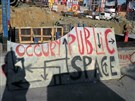During June 2013, the Occupy Gezi Movement emerged as the greatest challenge to Prime Minister Recep Tayyip Erdoğan’s decade-long rule in Turkey. In the streets and in Gezi Park, as well as through its widespread use of social media such as Facebook and Twitter, the resistance movement has produced images in both real and digital spheres. Much of the visual output strikes at Erdoğan’s hubris and verbal threats, his attacks on personal freedoms, his brutal crackdown against the protests, and his pressuring of mainstream media into self-censorship. Although they conveyed serious concerns, the movement’s rhetorical and pictorial messages were often humorous, witty and intellectually alluring in their use of wisecracks and satire. Such levity offered biting commentary on the obscenity of police violence while also building group cohesion for an array of oppositional constituencies.
The demonstrations spread beyond the initial environmental sit-in in Gezi Park when tents were burned and a woman wearing a red dress was teargassed by a police officer. The brutal chemical attack left her gasping for air and caused her to collapse on a bench. It has since come to light that this woman is Ceyda Sungur, a faculty member specializing in urban planning at Istanbul Technical University. She, her colleagues and students, and other concerned citizens had been arguing that Istanbul needs green “lungs” to breathe. Sungur’s image became one of the main icons of the Occupy Gezi movement. As her image gained traction, so did public criticism of the police’s use of tear gas against increasing numbers of demonstrators. The excessive amount of gas led graphic designers and stencil-makers to ominously warn: “The more you press, the bigger it gets.”
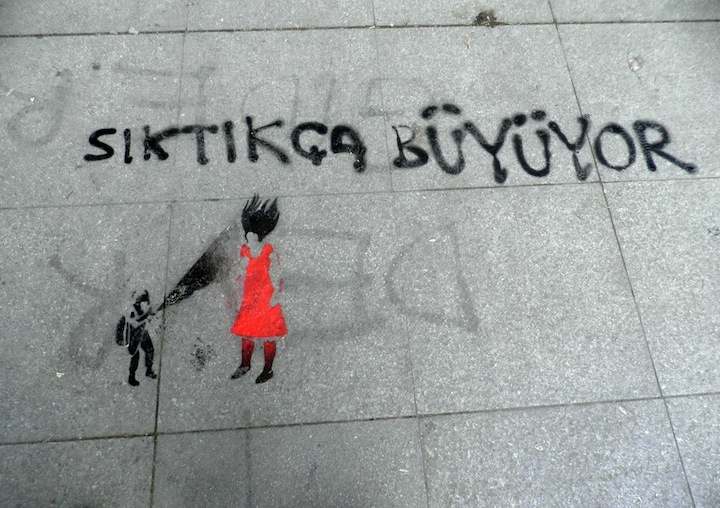
[“The more you press, the bigger it gets,” stencil on the ground in Gezi Park, 4 June. Photo: Christiane Gruber.]
Mass-intervention vehicles (TOMAs in Turkish), water cannons, tear gas, rubber bullets, and sound bombs were the police weapons of choice. Most stunning was the apocalyptic amount of tear gas that engulfed Istanbul, Ankara, and other Turkish cities during the first two weeks of June, when it is estimated that Turkey used upwards of 150,000 tear gas bombs. Besides its burning and asphyxiating effects, tear gas belongs to a booming market in non-lethal weapons of mass control whose purchase benefits authoritarian and neo-liberal systems alike.
Although reeling from the effects of tear gas, demonstrators immediately turned the chemical into satirical counter-attacks on Erdoğan, the AKP, and security forces. Using street talk, graffiti sprayed along Istiklal Avenue and other streets in the Taksim area after the first major gas attack on June 1 proclaimed sarcastically: “Pepper spray, olé!”; “This gas is awesome, dude!”; “Another serving of gas, please!”; and, on the metal shutter of MAC Cosmetics, “Pepper spray beautifies the skin.”
.jpg)
.jpg)
[Left: “Pepper spray, olé!” Istiklal Avenue, 2 June. Right: “This gas is awesome, dude!” Istiklal Avenue, 2 June. Photos: Christiane Gruber.] 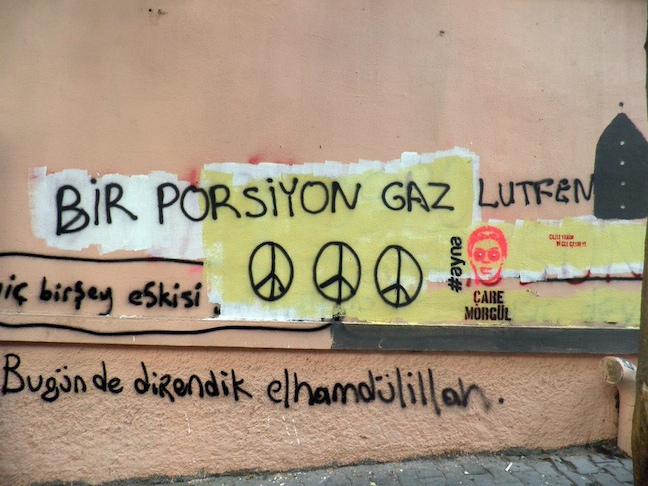
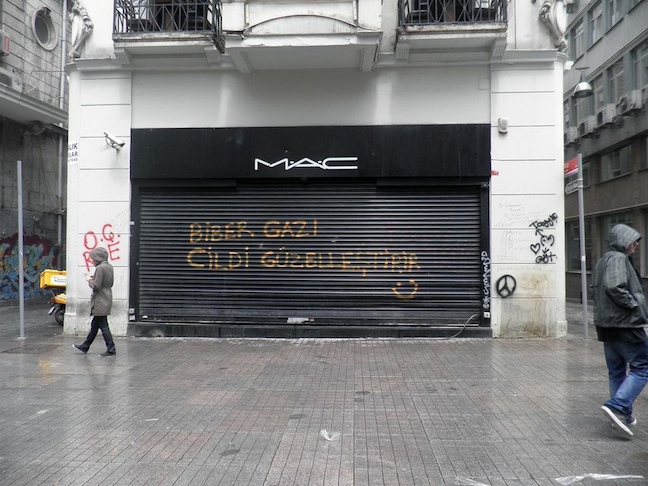
[Left: “Another serving of gas, please!” Cihangir, 9 June. Right: “Pepper spray beautifies
the skin,” MAC Cosmetics, Istiklal Avenue, 2 June. Photos: Christiane Gruber.]
Playing on the phonetic similarity between the terms “gaz” (gas) and “caz” (jazz), protestors created graphics, banners, and graffiti issuing a smiley-faced “Welcome to the First Traditional Gas Festival” of Istanbul, while also resiliently daring the police to bring on the “vizzzzz” of their water cannons and tear gas. They refused to desist, proudly declaring that “We came to the gas,” the expression “to come to the gas” (gaza) meaning “to get pumped up.”
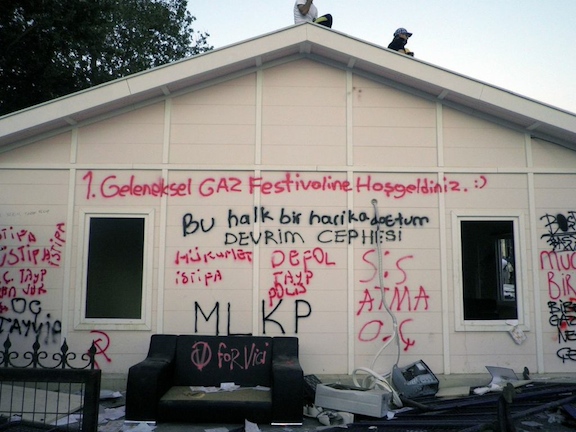
[“Welcome to the First Traditional Gas Festival,” burned police quarters, Gezi Park, 1 June. Photo: Christiane Gruber.] 
[“Your TOMAs and your gas are nothing to us" (with a play on the "vizzzzz" sound of water cannons
and gas canisters), Taskim Square, 1 June. Photo: Christiane Gruber.] 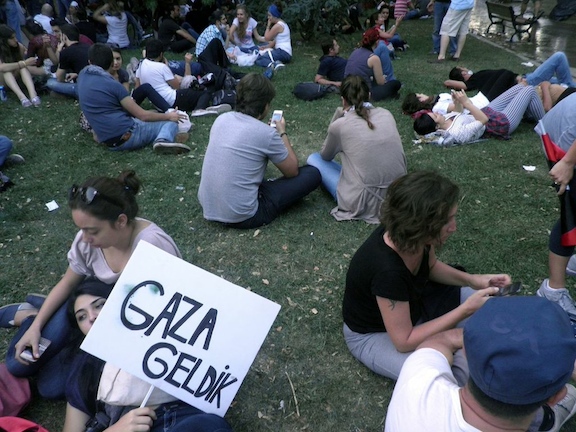
[“We came to the gas,” Gezi Park, 1 June. Photo: Christiane Gruber.]
Further playing on the term “biber” (as in “pepper” spray), protestors unleashed scathing commentary on the ruling AKP government, calling it nothing but a malodorous “pepper-sauced democracy.” Additionally, “biber” also invited a slew of spoofs drawn from youth and pop culture, effectively bringing teenage musician Justin Bieber into the mix. Online images superposed a caption reading “Just-In-Biber” over a photograph of a demonstrator engulfed in clouds of white gas, while graffitists in the streets of Istanbul swoon amorously as they exclaim “Oh Biber” in pink hearts. Still others simply nicknamed the prime minister “Tayyip Biber.”
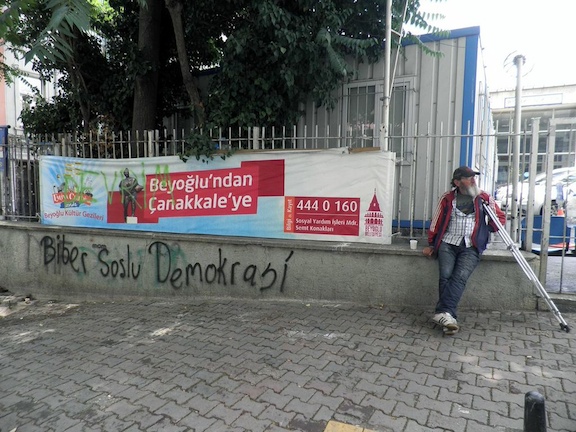
[“Pepper-sauced democracy,” Cihangir, 2 June. Photo: Christiane Gruber.]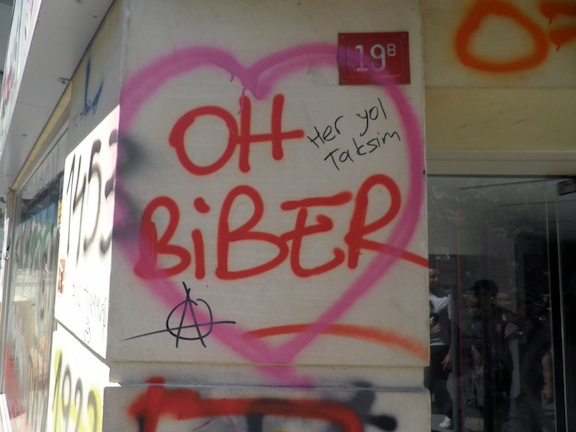
[“Oh Biber,” Gümüşsuyu, 9 June. Photo: Christiane Gruber.]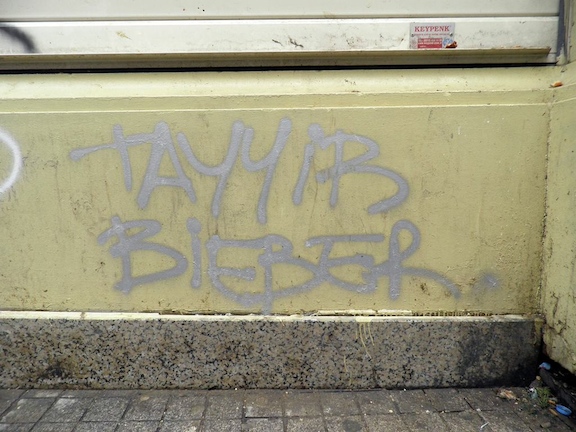
[“Tayyip Bieber,” Gümüşsuyu, 2 June. Photo: Christiane Gruber.]
Meanwhile, Erdoğan’s title of “prime minister” was turned into “primitive minister” and other diminutives and expletives were omnipresent as graffiti. Among these were word plays on “gas,” wherein Erdoğan was nicknamed “Gazman” and “Chemical Tayyip.” The latter was reminiscent of “Chemical Ali,” the nickname of Ali Hassan al-Majid, Saddam Hussein’s defense minister best known for overseeing the 1988 chemical attack against the Kurds of Halabja. In this case, the abuse of tear gas is thus potentially linked to the long-standing grievances of the Kurdish minority in Turkey.
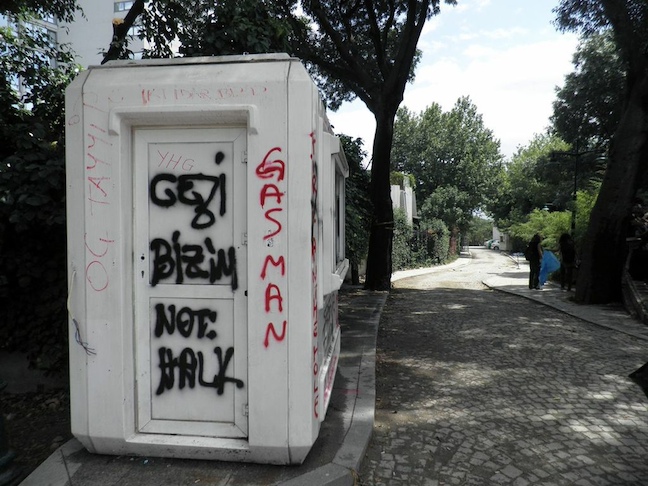

[Right: Booth with graffiti reading “Gasman” and “Gezi is ours. Signed: The People,” Gezi Park, 2 June.
Left: “Chemical Tayyip” gas mask stencil, Galatasaray, 4 June. Photos: Christiane Gruber)
At other times, the prime minister’s full name, “Recep Tayyip Erdoğan,” was scrambled with the Turkish words for baton, (water) pressure, and gas to yield “Recop Tazyik Gazdoğan,” a triad synopsizing the three main weapons used to suppress Gezi protesters. Finally, Erdoğan also was anthropomorphized as a red-hot chili pepper, as Marie Antoinette stating that “If there is no bread, let them eat gas,” and as a horned Tasmanian (“Gaz-mania”) devil swirling in a funnel of tear gas as it demolishes trees in its path.


[Left: “Recop Tayzik Gazdoğan” Istiklal Avenue, 5 June. Right: Watercolor painting
of the “Gaz-mania Devil,” Gezi Park, 6 June. Photos: Christiane Gruber.]
In all of these graffiti and images, demonstrators displayed daring nonchalance, engaging in youthful and mocking backtalk, slamming state-sponsored chemical warfare, and mourning the devastation of their natural environment, including the uprooting of the trees of Gezi Park and the poisoning of the air that citizens need to breathe and live.
As the protests spread, so did an overall indictment of the government and the AKP. Beyond its worldwide record of imprisoning journalists and its curbs on freedom of speech in the mass media, the AKP has consolidated power in a number of other ways, including through the cleptocratic coopting of public property for private gain. Protesters thus took on the logo of the AKP—a light bulb radiating yellow light, indicative of enlightenment—and either destroyed or reconfigured its symbolic meanings. In some instances, the bulb shatters under the impact of a revolutionary fist or a growing sapling, while in others it is remodeled into a gas mask, radiating a neon green light. Exuding toxicity rather than sunlight, the AKP’s logo is the object of an iconoclastic act whose ultimate aim consists in showcasing the party’s willingness to resort to chemical warfare to ensure the success of its own Islamo-capitalist ventures.
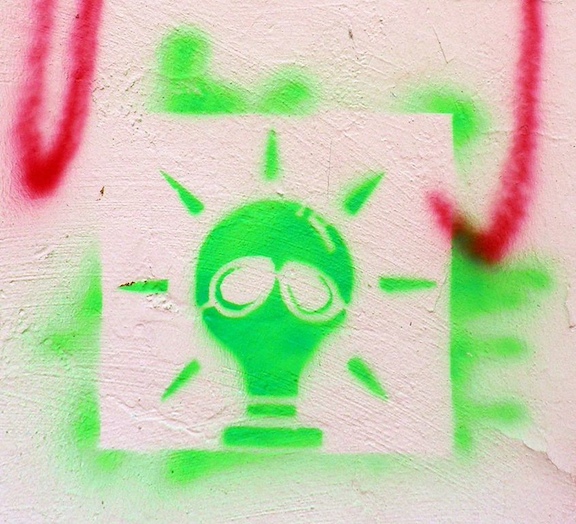
[AKP light bulb remodeled into a neon green gas mask, Galatasaray, 12 June. Photo: Christiane Gruber.]
As a new visual culture of gas emerged during the Occupy Gezi movement, not all references to police brutality were scornful or iconoclastic. Strangely, the presence of tear gas became normalized, even expected. By 3 June, Taksim had come to resemble a political carnival, where peddlers of foods and wares offered meatball sandwiches, corn-on-the-cob, cotton candy, roasted chestnuts, watermelons, and cucumbers alongside Atatürk memorabilia, banners and pins, Turkish flags, whistles, goggles, and medical masks. Commercialized within this new gas culture, goggles, masks, and helmets catered to the very real necessity of self-protection against water and gas attacks while also functioning as newly articulated marks for their wearers’ oppositional identities.
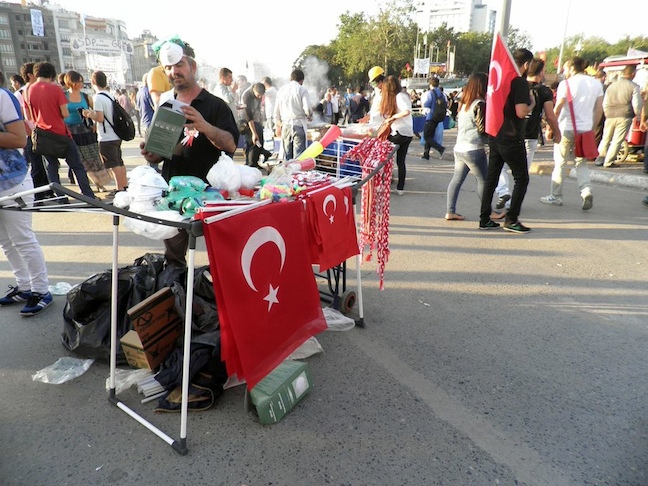
[Seller of Atatürk memorabilia, banners, pins, Turkish flags, whistles, goggles,
and medical masks, Taksim Square, 3 June. Photo: Christiane Gruber.]
This uncanny masquerade was in turn strengthened by other performances that engaged in visual paradox and disjuncture, including dances by ballerinas and whirling dervishes wearing gas masks. A photograph of the latter became—much like the lady in a red dress—a pervasive icon of the movement; it quickly turned into a stencil urging demonstrators, in the words of Mevlana, to “come yet again” (sen de gel) to show support for the Occupy Gezi movement. As both political commodities and stage props, goggles and gas masks were embraced for their eerie theatricality, speaking volumes to the grotesque banality of living under billows of noxious gas.
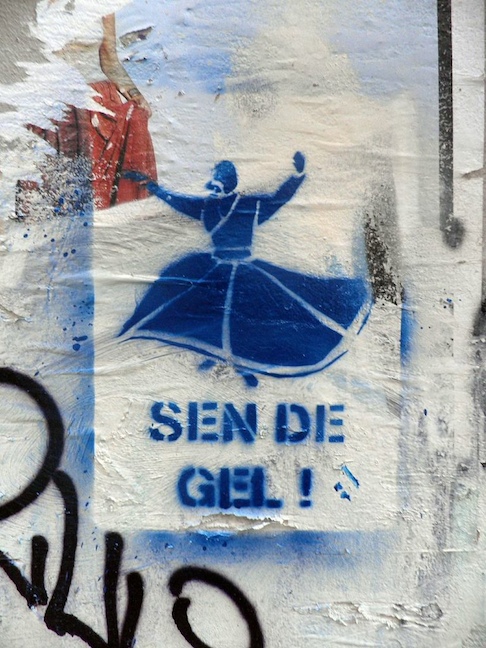
[Stencil of a whirling dervish wearing a gas mask with Mevlana’s invitation to
“come yet again” (sen de gel), Galatasaray, 14 June. Photo: Christiane Gruber.]
Still other visual practices stress the Gezi movement as one of civil disobedience. Protesters offered peaceful and hopeful counter-images to the unrelenting gas attacks. Among them circulated photographs of empty tear gas canisters, clicked together in a chin-chin motion as if they were rakı glasses. At the same time, demonstrators took to Taksim Square, where they sat on elevated platforms to display empty gas canisters filled with green branches, in a gesture symbolic of the renewal of life and nature. Within Gezi Park, the exterior façade of the makeshift “Museum of the Revolution” also included an “Art Platform,” which invited visitors to paint freely. Among the many written messages and pictorial images could be found a prominent depiction of a gray gas mask, in whose “eyes” bloomed large pink flowers.

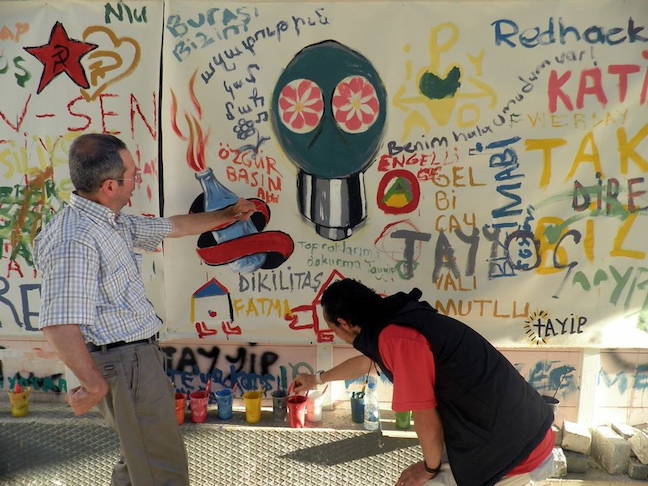
[Left: Protester displaying an empty gas canister filled with a green branch, Taksim Square, 1 June. Right: Painting of a gray
gas mask with blooming pink flowers, Art Platform, Museum of the Revolution, Gezi Park, 10 June. Photo: Christiane Gruber.]
In the end, these many messages, photographs, and images are hopeful, in some sense offering a branch of peace in the midst of violence. Above all, they herald the triumph of people over police, of peace over barbarity.
[Part two of this series can be found here.]
[Part three of this series can be found here.]
![[“Oh Biber,” graffiti in Gümüssuyu, 9 June 2013. Photo by Christiane Gruber.]](https://kms.jadaliyya.com/Images/357x383xo/Gruber_figure10.jpg)

